Mack’s back in medium duty
We haven’t seen the Bulldog on the hood of a medium-duty truck since the early aughts when Mack retired the Freedom Series and the CS300P, a conventional version of the Mid-Liner. With a big push from its dealer network, Mack returned to the medium-duty space in January with the launch of the MD Series platform.
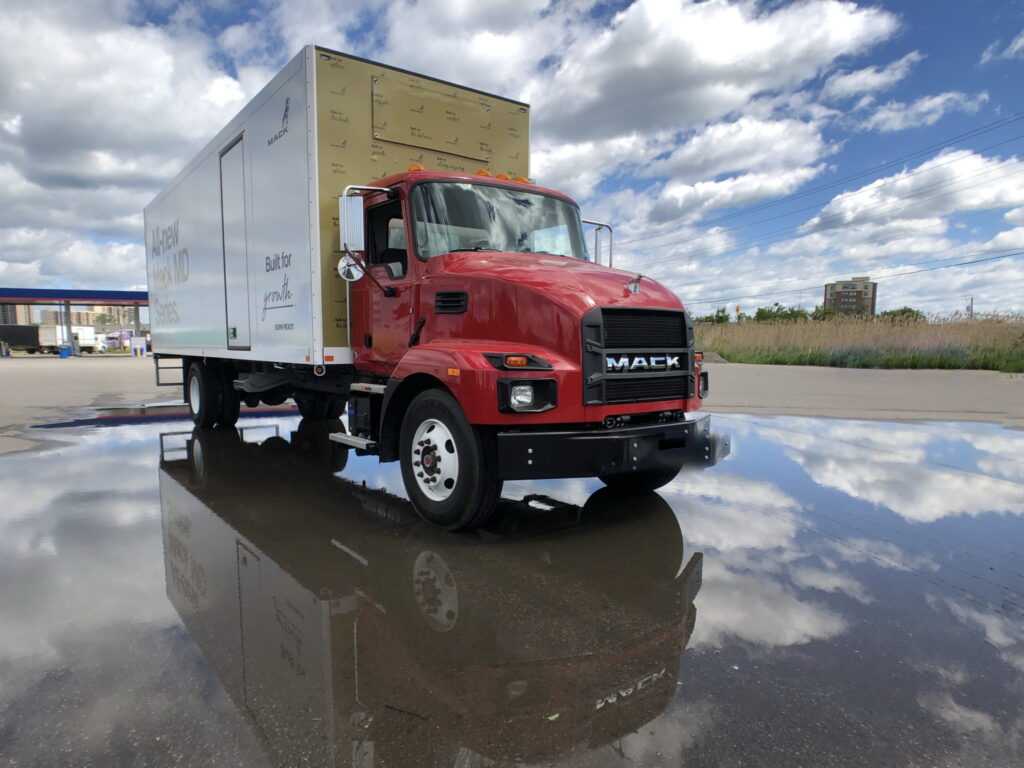
The MD Series is a pair of Classes 6 and 7 straight trucks aimed at private fleets and the pickup and delivery crowd, which is not Mack’s traditional customer base, but their number are just too large to ignore. About 100,000 medium-duty trucks are sold each year in North America, and unlike the wild swings we see in on-highway Class 8 models, sales of the lighter classes are steady and predictable, and Mack’s out to claim its share of that market.
“MD is a good strong market, and it makes sense for Mack to become a full-line, Class 6-8 supplier to the industry,” said Jonathan Randall, Mack Trucks senior vice-president of North American sales and marketing, speaking at the reveal of the MD model at the Work Truck Show in early March.
At the time (a few weeks prior to the real onset of the coronavirus pandemic), Randall was predicting orders for 240,000 Class 8 trucks for 2020, with a slight shift in the product mix of product registrations, favoring work trucks and straight trucks at the expense of highway trucks. Little could he have known then that orders for all types of medium and heavy trucks would be slashed by the pandemic. As of June, Class 8 orders were down about 37% and Classes 5-7 orders were down 54%, according to ACT Research and FTR.
Adding the MD to the lineup won’t help Mack much this year, but along with the Granite and LR models, the company’s product mix will be a little less susceptible to the swings in demand historically seen with highway tractors.
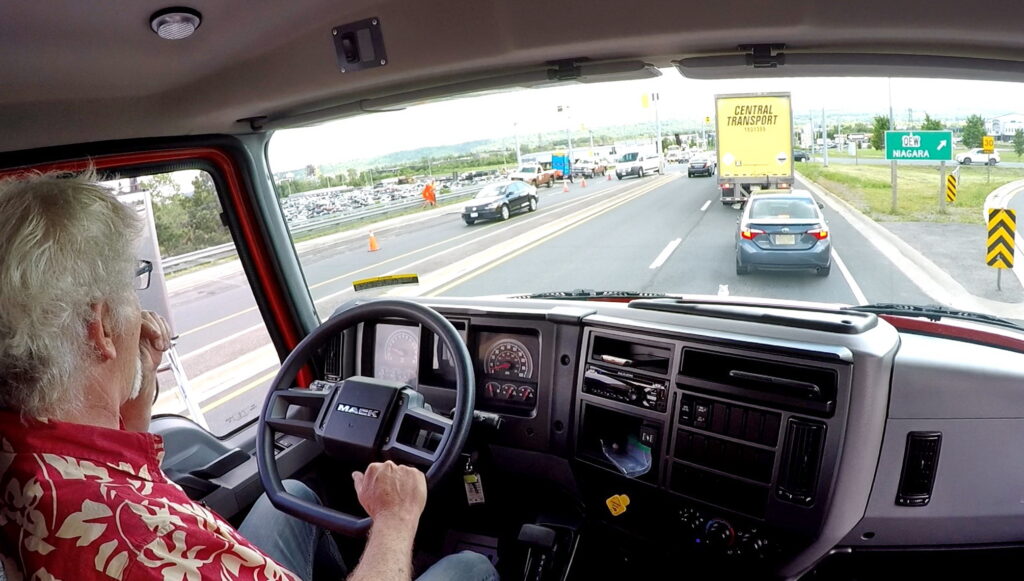
The MD is initially targeted for the van/reefer box truck segments along with stake trucks, dumps and tankers, Randall said. “Those four segments make up about 70-75% of the total Class 6-7 market. Within the 100,000-truck total medium-duty market, about 65% are Class 6, the rest are Class 7. A lot of our Class 8 customers are in the medium segments too, but they had to go somewhere else to satisfy their Class 6 and 7 needs. Now they have a single source for their equipment needs, and the MD opens up additional markets for us as we continue to grow our share of the market.”
Mack will build the MD at a new facility in Roanoke Valley, Virginia.
In addition to killing truck sales, the pandemic also put a serious crimp in editors’ travel plans, meaning, no more test drives. So, imagine my surprise while driving to Toronto from my home in Niagara earlier this summer at seeing an MD7 parked at the Vision Truck Group’s dealership in Stoney Creek, Ontario. It had been shipped to Canada for an appearance at Toronto’s Truck World trade show, which was eventually postponed due to the pandemic. I made a few calls to inquire about doing a test drive with it and after procuring all the official blessings, we had a date arranged. So, this is a global exclusive: the first socially distanced, masked test drive. You read it here first, folks.
MD Series
The MD isn’t Mack’s first medium-duty rodeo. The company offered a low-cab-forward Class 6 model called the Mid-Liner from 1979-2001, when it was replaced by the Mack Freedom. (Both were built by Renault in France, which had a stake in Mack starting in 1979, with Mack becoming a wholly owned subsidiary in 1990. Volvo bought Mack and Renault in 2001).
Mack introduced a conventional version of the Mid-Liner, the CS300P, in 1988. The company withdrew from the medium-duty market altogether in 2003 when production of the Freedom series came to a halt.
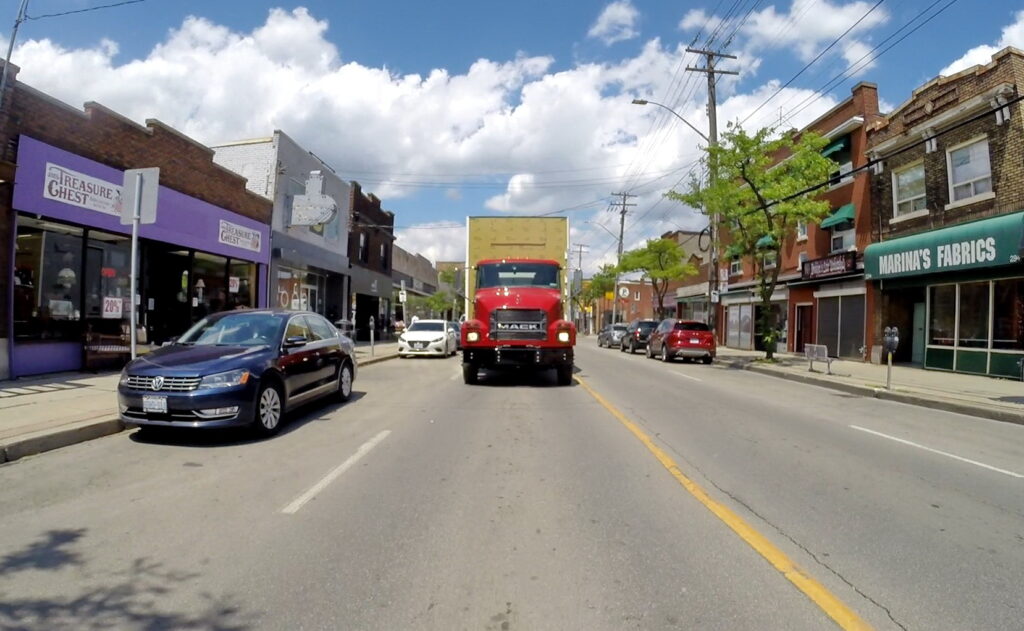
Mack will build three versions of the new truck: a Class 7 MD7 (11,793 to 14,968 kg GVWR), a Class 6 MD6 (8,845 to 11,793 kg GVWR) and a low-profile version of the MD6 with low profile 22.5-inch tire (255/70R 22.5) and lower chassis height. The MD6 will not require a commercial driver’s license to operate, but the MD7 will. Both versions are equipped with air brakes, so operators will need air brake endorsements where applicable.
The suspension and axle ratings on the MD6 are lighter, 10,000 and 17,000 pounds, compared to 12,000 and 21,000 for the MD7. Both offer Mack’s AL 190 (19,000-lb)/AL 210 (21,000-lb) optional rear air suspensions and rear-axle uprates to 21,000 pounds.
Chassis configurations accommodate body lengths of 10 to 26 feet on eight wheelbase options ranging from 150 to 270 inches.
The MD6 comes with 7-mm frame rails, while the MD7 features an 8-mm frame. Both are rated at 120,000 psi yield strength compared to the industry-standard 80,000 psi. Other than that, the two trucks are basically the same.
Mack brought many of the amenities found in the Class 8 Anthem cab over to the MD cab, including the stylish dash A and B panels and the flat-bottom steering wheel. Various bits of interior door and cab trim come from the Granite and Anthem models. The cab shell and doors are based on the Granite, and the cab has a dual air-bag cab suspension for additional driver comfort and structural durability. The only significant modification from the previous cab design is the wrap-around portion of the dash B-panel, which had to be set forward a few degrees to make more knee room for the folks sitting in the center position of the bench seat.
Standard features include power windows and door locks, cruise control, air conditioning, and an air-ride high-back driver’s seat, which are sometimes available only as optional upgrades on other Class 6 and 7 models. Almost everything a driver could want comes standard with the MD, so there’s not a long list of options available.
The short 103-inch bumper-to-back-of-cab measurement gives the cab a decidedly retro “bull-nose” look. This give the advantage of a shorter turning radius and the ability to put a little more weight on the front axle in higher-payload applications.
Visibility is outstanding to the front and sides, and the cut-away side windows offer a view very close to the side. A peephole window is standard on the passenger door.
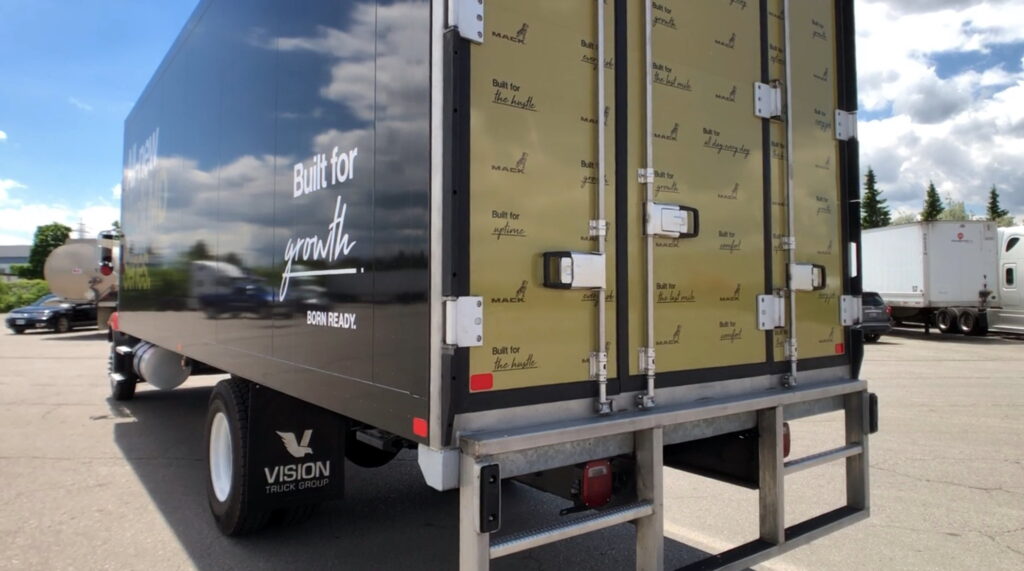
The cargo box on the MD I drove, a 26-foot Schmitz Cargobull M.KO COOL insulated body, was supplied by Gincor Werx of Blenheim, Ont., and it’s a unique specimen. It was made in Germany by Schmitz Cargobull and installed on the MD for Truck World. Gincor Werx is the exclusive Canadian distributor of the product. It’s built like no other refrigerated body I have ever seen. The styling of the body, the door latches, the interior finish were all fresh to my tired eyes. It’s built with patented Ferroplast panels that give it a distinctly European look. No disrespect to the MD, but by the look of the construction of that body, it would probably outlast two MDs. Talk about your brick &%$?# house.
Powertrain
Since Mack doesn’t make a medium-duty powertrain, Cummins and Allison got the nod for the MD Series. The on-road version of the Cummins B6.7 is well proven, having been in production for 38 years. Cummins says B6.7 engines in the 200-260 hp rating family can typically deliver an 8.5% fuel economy improvement over the EPA13 version thanks to improvements to combustion and aftertreatment system design resulting in increased airflow to the VGT Turbo. Mack offers the B6.7 in ratings from 220-300 hp with 660 lb.-ft. of torque across the board.
The single module aftertreatment system combines diesel particulate filter, selective catalytic reduction, and diesel exhaust fluid dosing in one unit. Non-CDL drivers will probably need some training on the DEF refill requirements and aftertreatment regen procedures, but other than that, the B6.7 is long on performance and light on maintenance requirements.
The Allison 2500 HS 6-speed automatic is an industry bulwark and needs practically no introduction. It comes standard with FuelSense 2.0 Plus. The 2500 RDS is an optional upgrade and it can be spec’d with FuelSense 2.0 Max and power take-off options.
All that to say, Mack is coming back to medium-duty with a strong-looking product offering that gives experienced truck buyers everything they would need in such a truck without overthinking the spec’. For buyers who see a truck simply as a means of getting product to market, it might take a bit of a nudge before they’ll see the value proposition compared to a bare-bones, utilitarian six-wheeled box. But the “Built Like a Mack Truck” mantra will probably hold water and help sell the MD as sure as its savvy standard spec’.
Driving the MD7
Before saddling up in the MD7, I had spent several hours up close to the truck shooting a Focus On video, so I had plenty of opportunity to poke into the nooks and crannies of the thing. It’s really well put together.
All the service points and driver inspection points are easy to access, with the possible exception of the auto transmission fluid level dipstick. It’s located up above the Cummins engine and might be a stretch for a vertically challenged driver. Otherwise, top marks for the pre-trip.
Everything in the MD cab checked out fine; after all, it’s based on the proven Anthem and Granite platforms. Driving position, steering wheel adjustment, sight lines, all great. The only rub was the transmission shift lever. It doesn’t have a “park” position, and the slot for reverse is at the top, where a driver might expect to find “park.”
‘I wasn’t an hour into the drive when I had made up my mind on the MD7, and it just got better from there.’
As we all do in cars, we shove the shift lever full forward when parking. If a driver were to forget to set the parking brakes before bailing out, believing the truck was in park, a few of these may wind up being chased around parking lots by frantic drivers. Since the MD6 will wind up in the hands of non-CDL drivers, this is probably something worth having a second look at.
Since the Vision Truck Group’s deal is in Stoney Creek, I took the truck over to Hamilton for a ride ’round the city’s industrial core and some of its commercial thoroughfares – Burlington Street, Ottawa Street, Queenston Road, etc. – for a taste of how it would handle in real life. I wound up on Ridge Road for a ride along the edge of the Niagara Escarpment with it’s gorgeous view of the Golden Horseshoe before heading down Mountain Road into Grimsby and back to the dealer along the QEW highway.
I wasn’t an hour into the drive when I had made up my mind on the MD7, and it just got better from there. We did about 15 miles at highway speed and I was shocked at how quiet it was in the cab. It was right up there with most of the high-end Class 8 models I’ve driven recently, including the Anthem. Having a conversation in the cab was not a problem.
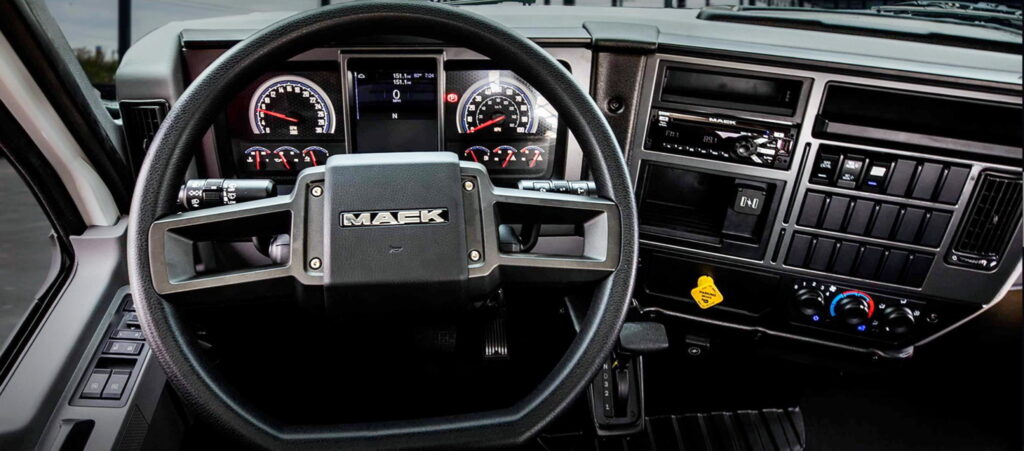
The steering was spot-on, and the handling on S-curves and less-than-perfect country roads was remarkable. It was right at home on downtown city streets, too. A right turn from the curb lane, owing to the length of the truck, required me to cross only slightly into the adjacent lane to complete the turn. Good marks for maneuverability, but if Mack could squeeze a few more degrees from steering geometry, they’d have it aced.
I really liked the Cummins/Allison combo, too. Allison’s FuelSense 2.0 really smooths out the upshifts and gives it an almost automotive feel. Drivers will really like that. And the B6.7 was peppier and much quieter than I expected.
Also, the mirrors are as solid as a rock. Absolutely no vibration in the wind at highway speed or while idling around the yard. That’s a huge plus.
Coming out of the gate, Mack is targeting the MD trucks at the local and P&D sectors, seeing it fitted with van and reefer boxes, flatdecks and even fuel tankers. I can see it as an expeditor (with a rear-axle ratio change) and probably even a battery-electric version. Mack wasn’t making any predictions, but this truck is designed for exactly the application best suited to electrification. Seems like a no-brainer to me.
Have your say
This is a moderated forum. Comments will no longer be published unless they are accompanied by a first and last name and a verifiable email address. (Today's Trucking will not publish or share the email address.) Profane language and content deemed to be libelous, racist, or threatening in nature will not be published under any circumstances.
Jim, You didn’t mention any safety technology on this truck. It seems to me that companies now focus on the new technology – emergency braking, etc. any info on these options available?
Nice article about this new vehicle- I’m sure the Mack dealers are excited to get this new medium duty product. I didn’t notice any info on safety technology systems on the vehicle. With customers in many cases considering this trch as standard, do you have an update coming with these features? (Lane keeping, emergency braking, smart cruise, command steer)
“The company offered a low-cab-forward Class 6 model called the Mid-Liner from 1979-2001…………Mack introduced a conventional version of the Mid-Liner, the CS300P, in 1988”.
We introduced the Mid-Liner “CS” conventional range including the CS200P, CS250P and CS300P rigids, and CS300T tractor.
The MS/CS 200 and 250 were Class 6.
The MS/CS 300 were Class 7.
The MD7 is missing an ISL option that the competition offers.
The MD is not offered as a tractor.
Good article,
But Mack still hasn’t figured out how to make a decent hood latch.
Have they at least introduced a gas-cartridge cylinder for ease of closing the hood?
And never having experienced a flat bottomed steering wheel – I am a bit leery – for example using two hands in a “bus driver” style turn of push and pull rather than hand over hand (remember days before power steering?)
Not just picking on Mack either.
I wonder if the engineers and designers actually try to use the equipment – eg. Freightliner’s hood latch at -25 degrees (F or C) with gloves or mitts – stuff works great in the south or in the shop – they should be forced to do something 50 or 100 times and then see if they can’t improve the design.
Probably the same guys that place the fridge on the floor of the bunk instead of raising it – try getting to something in back without having to kneel on the floor, or if you have removable carpets and the fridge door won’t open.
– or placing the electrical outlet on the bunk frame right beside the fridge door – I guess no one ever leaves anything plugged in interfering with opening the door.
How about investing in some real world drivers putting the truck through its paces and on bad weather days – not nice sunny ones.
Cheers